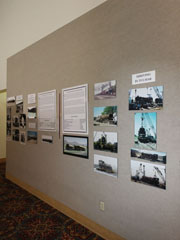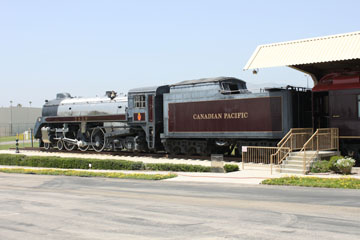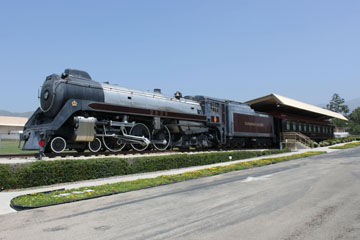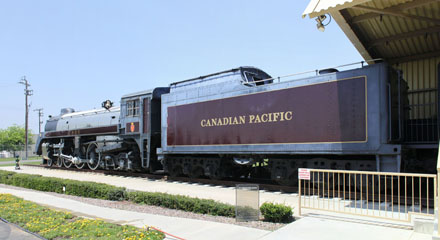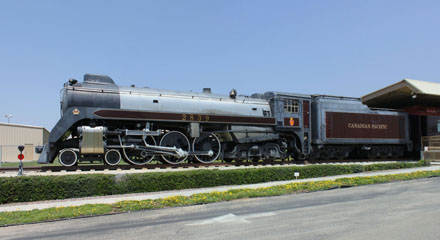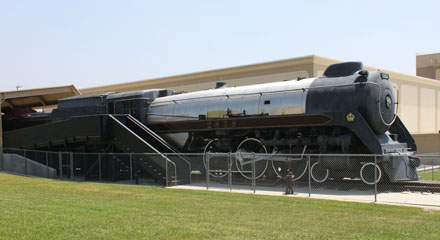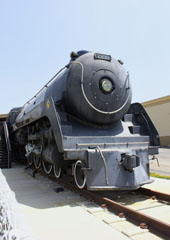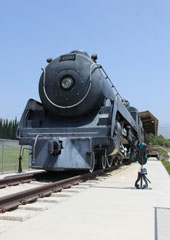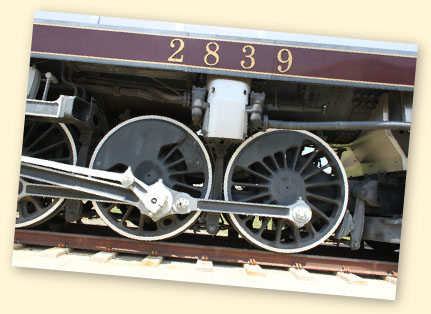

Canadian Pacific H-1-c #2839 is one of thirty Hudson
(4-6-4) type locomotives built by Alco subsidiary, the Montreal Locomotive Works, in 1937. It is on open air display in the grounds of the Nethercutt Museum at 15151 Bledsoe Street, San Fernando Valley, CA.
The museum was founded by J. B. Nethercutt who went into business with his aunt and founder of Merle Norman Cosmetics. In 1956, JB and his wife began collecting historic automobiles. Their collection grew and, in 1971, they opened the current building to make it available to
the public. Today, it is managed by JB’s son, Jack Nethercutt and his wife, and includes two hundred and
fifty American and European automobiles dating from
1898 to 1997. It is open to the public Tuesday-Saturday
9.00 am to 4.30 pm except for most public holidays. Entrance is free.
A separate building houses the Nethercutt Collection, an eclectic mix of automobile mascots, antique furniture, clocks, watches and mechanical musical instruments. The collection can be viewed by guided tour only on Thursdays, Fridays and Saturdays at 10.00 am or 1.30 pm. It is closed most public holidays.
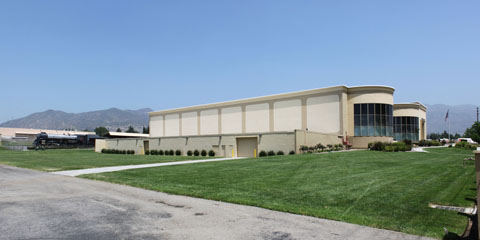
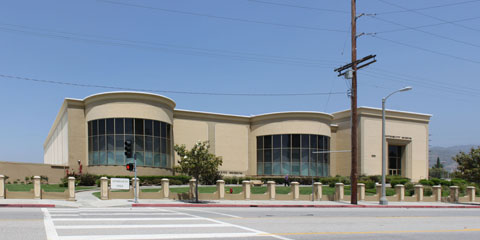
Top photo, #2839 peaks out from behind the rear of the museum. Right, there are photos of #2839 and tender making the move from Hamburg, PA, to San Fernando Valley in 1999 on rail flat cars, as well as interpretive signs inside.
Restoration work started on #2839 as soon as it arrived in California. It was completed in time for the locomotive’s formal dedication ceremony on 5th April 2002.
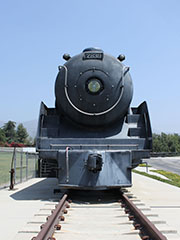

The CPR ordered its first twenty Hudsons from
the MLW in the late 1920s. The first ten, Class H-1-a locomotives
(#2800-#2809), were delivered in 1929, the second ten, Class H-1-b (#2810-#2819), in 1930.
They were intended to improve on the CPR’s Class G-3 4-6-2s.
The two axle trailing truck on the new 4-6-4s supported a 23% larger fire grate than the G-3 and a boiler with a large superheater and combustion chamber. The new locomotives with their larger tenders reduced the number of locomotive changes required to haul trains across Canada from fourteen to just nine.
The twenty H-1-c Hudsons delivered in 1937
(#2820-#2849) were followed in 1938 by ten Class
H-1-d (#2850-#2859) and a further five Class H-1-c in 1940 (#2860-#2864) bringing the CPR’s total roster to sixty-five.
The locomotives acquitted themselves well on the 3,224 mile trip, apparently greatly impressing King George VI. After the tour, both were returned to the railroad’s standard livery but, later, the CPR was given permission to place the crown on the skirts of its newer 4-6-4s (#2820-#2864) and to designate them "Royal" Hudsons.
Retirements began in the 1950s, although some of the locomotives ran into the mid 1960s. #2389 last steamed in
1950 and was officially retired in 1959 after having run more than three million miles. In 1963, it was sold to the
Government of Ontario and then, in 1969, to the Royal Hudson Company.
The CPR Hudsons were designed primarily for fast passenger service and could reach speeds of 90 mph with fifteen car passenger trains. They were extremely reliable in service, averaging 110,000 miles a year.
In 1939, H-1-d #2850 was assigned to haul the train carrying King George VI and Queen Elizabeth from Quebec to Vancouver. H-1-d #2851 also led a pilot train that proceeded the “Royal” train by one hour. Both locomotives were specially liveried for the assignment with Royal blue and silver paint, stainless steel boiler cladding, the royal arms painted on the tender and another crown painted on the skirt just ahead of the cylinders.
In 1972, #2389 was leased to the Atlantic Central Steam Railroad in Bath, PA, where it was restored to full operation. It was then leased to the Southern Railway and briefly hauled passenger trains on the steam excursion programme in 1979-80. However, it was not sufficiently powerful for the runs it was required to make and was subsequently leased to Historic Red Clay Valley Inc., in Greenbank, DE, and then Blue Mountain & Reading Railroad in Hamburg, PA.
The Blue Mountain and Reading tried to restore and run #2839 on excursions, but it was ultimately sold and went through a series of other owners before being purchased by the Nethercutt in 1999.
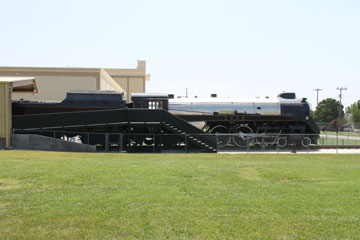
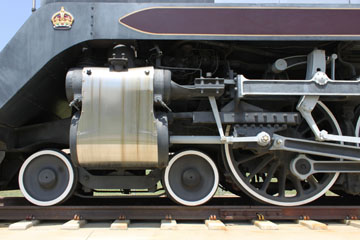
#2839 is 90’ 10” long from the front pilot buffer
to the rear tender buffer and weighs 354,000 lbs, 186,800 lbs on its 75” drivers. It has a driver wheelbase of 13’ 2”, an engine wheelbase of 39’ 6” and 22" x 30" cylinders. The grate is 80.8 sq ft and the 326 sq ft firebox includes 38 sq ft of arch tubes. With a total heating surface of 5,431 sq ft, including 1,640 sq ft superheating, #2839 operated at a boiler pressure of 275 psi delivering 45,254 lbs tractive effort.
The tender weighs 288,650 lbs light with a 21 ton coal and 14,400 gallon water capacity.
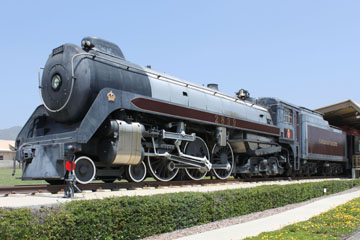
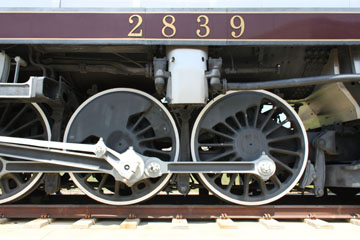
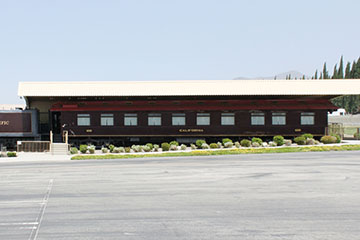
#2839 is on display with a private car built by the Pullman Company in 1912 and named “California” for Clara Baldwin Stocker, eldest daughter of the California pioneer and businessman E. J. “Lucky” Baldwin. The “California” is 81’ 11⅝” long and weighs 160,000 lbs. It has a cast steel and steel channel frame and is constructed of sheet metal over a wooden frame.
The Nethercutt devoted three years to restoring the car to how it appeared in 1912 using original Pullman blueprints and build sheets, historic manuscripts and photos.
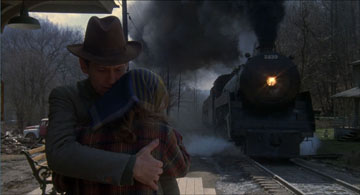
Above, #2389 made a curious appearance in the Coal Miner's Daughter. Curious because no CPR locomotives ever ran in West Virginia.


